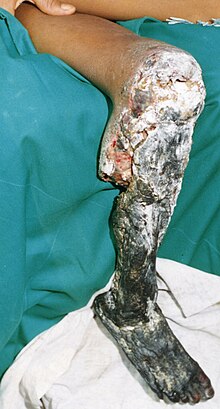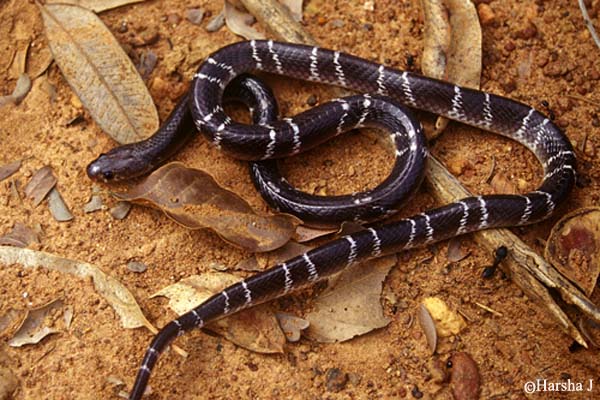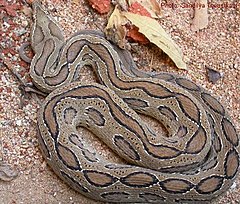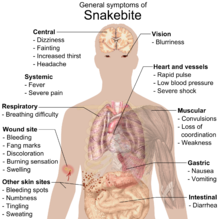

 According to world health organisation (WHO) , an estimated 2.5 lakh Indians are bitten every year out of which 50,000 die . India is effectively the snakebite capital of the world , recording the highest death rate !!!
According to world health organisation (WHO) , an estimated 2.5 lakh Indians are bitten every year out of which 50,000 die . India is effectively the snakebite capital of the world , recording the highest death rate !!!Not all the snakes are poisonous , there are over 2,700 species of snakes in the world of which around 450 are venomous .India is a home for 13 highly poisonous snake species .
The following picture is a 20 year old guy , who had to lose his leg because of the wrong method of first aid ( age old myths ). Correct First Aid given to the snake bite victim is of utmost importance .

The common snakes in India are :
1) COBRA

Cobra is very commonly seen venomous snake in India . It is easily identified by its hood . It is toxic to the nervous system of the human body , it can also be toxic to the heart .
2 ) BANDED KRAIT

Krait's mainly bite in the night , they are quite lazy and submissive during the day unless they are provoked . Kraits are toxic to the nervous system as well . There has been a case report of a bullock bit by a krait and the bullock died within 60 minutes !!!
3) COMMON KRAIT

Common Krait is highly venomous snake in India . I repeat , Common Krait is highly venomous snake !!!! have you ever heard of cannibals among snakes ?? Common kraits are cannibals among snakes , they eat the younger common krait's . The venom is highly toxic to the nervous system !! It also bites more commonly in the night .
4) RUSSELL'S VIPER :

Who is Russell's ? its the name of the doctor who first described it ., Dr.Patrick Russell ( 1726 - 1805) Russell's viper's venom is toxic to the blood , like it causes unclotted bleeding for a prolonged time from various sites of the body . The victims can bleed to death !!
5) SAW-SCALED VIPER :

These snakes are quick-tempered , they are toxic to the blood too .The have scaled skin with serrated keels , which produce a a sizzling sound when it becomes aggressive , so when you hear this sound in a forest or outskirts , watch out for this deadly species !!!
6) HUMP NOSED VIPER :

As it is named its nose has a hump . During the day it gets coiled in the bushes , bites in the night . When annoyed it will vibrate its tail . It is toxic to the blood and more commonly can cause kidney failure .
How to identify a poisonous snake ?
1) vertical slit pupils
2) small pit indentation between the snake's eye and nostril
3)Arrowhead-shaped head
How to identify a non-poisonous snakes ?
1) round eyes
2) no pit
3) round head
When bitten by a snake there would be a bite (fang) mark like the one shown below

What one could have after snake bite :

1) Oozing of non-clotted blood from the bite site
2)Severe pain
3) Numbness
4) Local swelling

5) giddiness
6) breathing difficulty
What to be done as a FIRST AID ?
1) Do not move the limb or the affected part of the body , as the poison may spread into the circulation faster.
2) Using a cloth or a towel wrap the affected limb from the most dependent position of the limb covering the entire limb .
3) Don't wrap the limb tightly , it should be of moderate degree . By doing it tightly you may cause the limb to die .



4) DO NOT try to bring the snake to the hospital alive or dead , that can create a situation even worse as you might get bitten again
5) If possible , take a picture of the snake that bit , if that's not possible try to remember what exactly the snake looked like so that the doctor can give you the right anti-venom .
5)There is a common saying " a set of keys is the best first aid for snake bite " meaning to say transporting the victim to the nearby hospital as quickly as possible .
6) The doctor will want to know if any of the signs and symptoms are noticeable on the journey to the hospital .
a)Difficulty breathing
b)Drooping eyelids
c)Bleeding from the gums or any unusual bruising appearing
d)Increase in swelling .Carry a pen and mark the limit of the swelling every 10 minutes

(note in the above picture the change in the marking of the pen , as the swelling increases )
e)Drowsiness
f)Difficulty speaking
g)Bleeding from the wound that does not stop
DON T'S AND MYTH'S
1) DO NOT apply tourniquet tightly

2) Do not incise or try sucking it ! , that's only for movie gimmicks ;-)

3) Do not apply ink , turmeric powder , ice , leaf extracts on the bite site as it may decrease the immune response

3) There are some people who believe that they shouldn't sleep the night snake bit them , its only a myth !!
THANK YOU FOR YOUR PATIENT READING !!
No comments:
Post a Comment